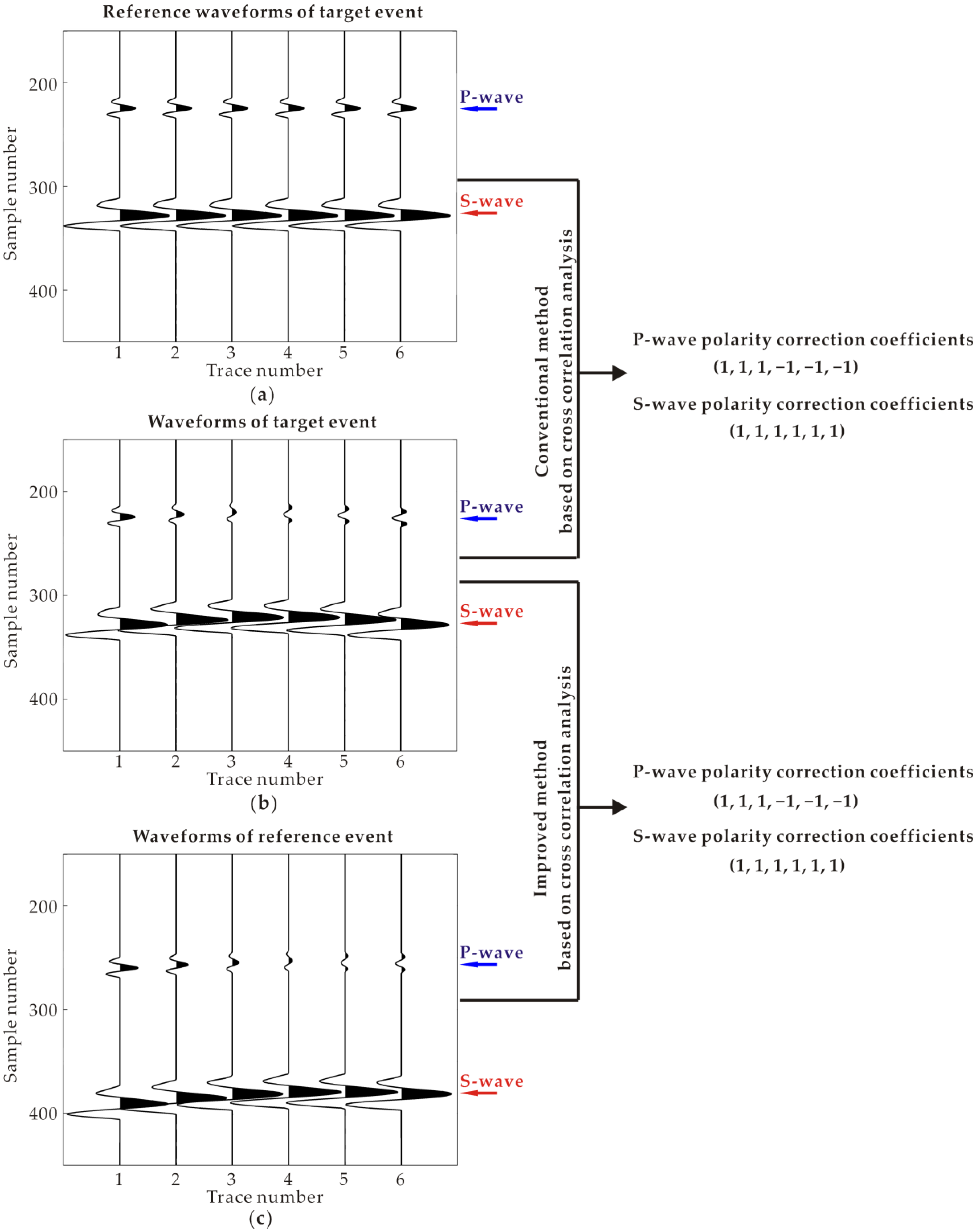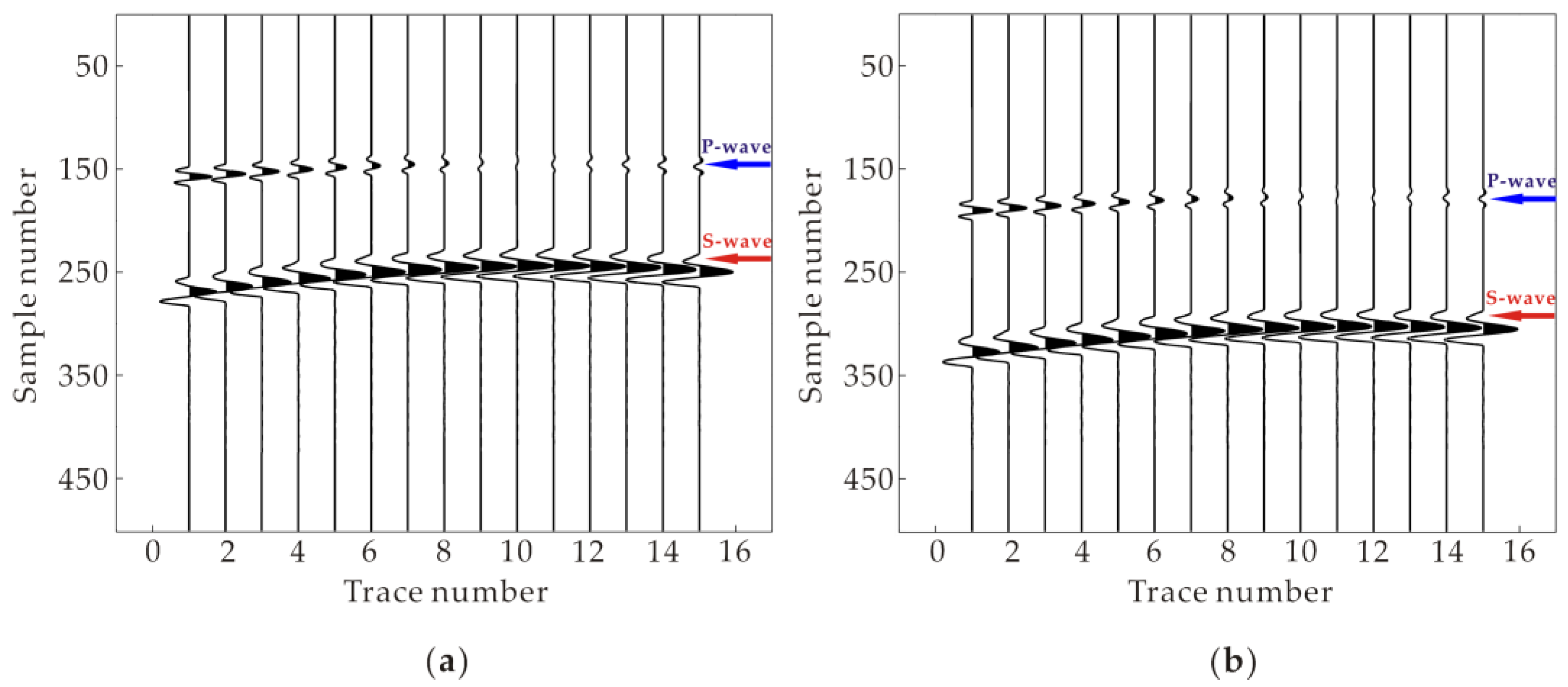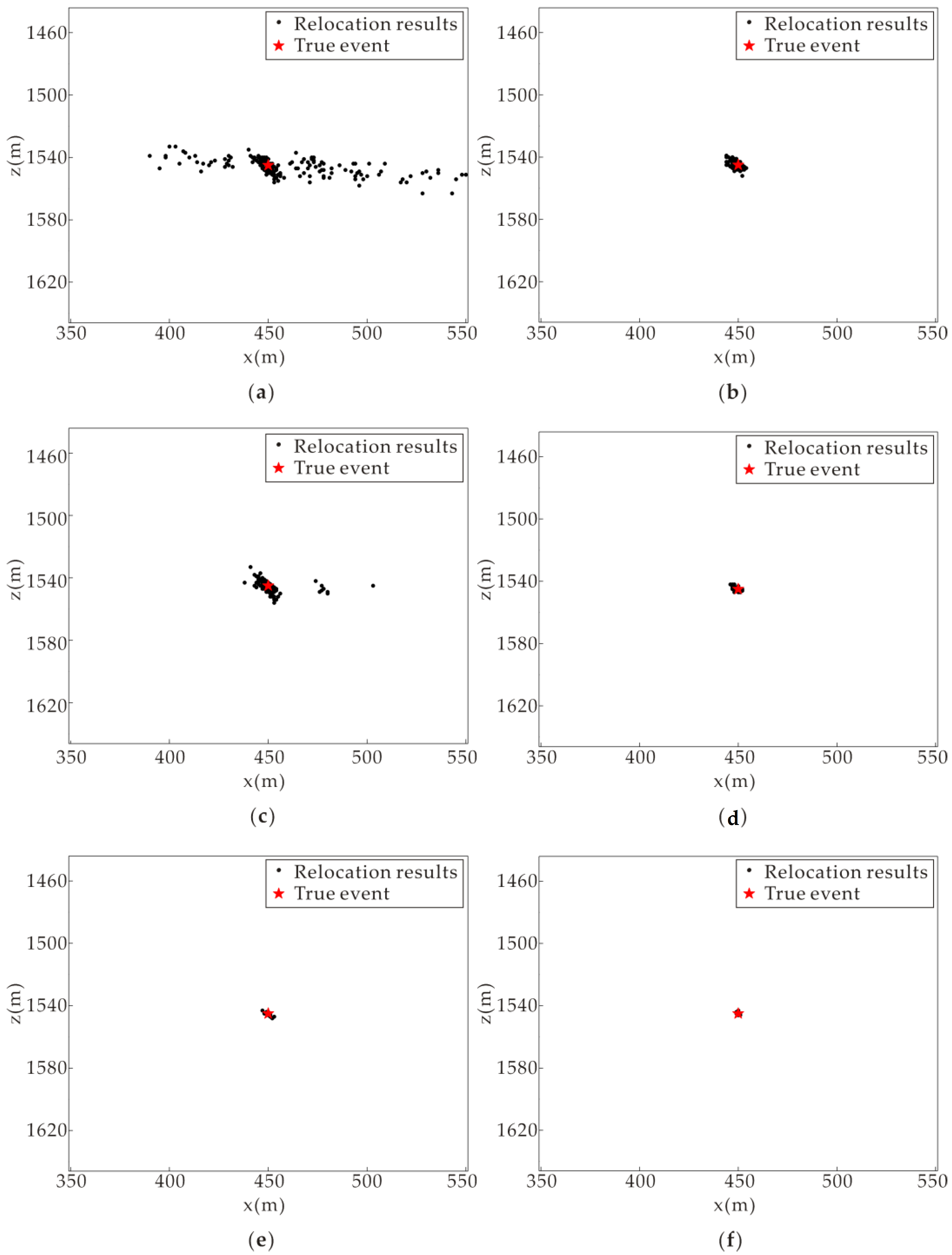A Novel Polarity Correction Method Developed on Cross Correlation Analysis for Downhole Migration-Based Location of Microseismic Events
Abstract
:1. Introduction
2. Methods
2.1. Polarity Correction
2.1.1. Conventional Polarity Correction Method Based on Cross Correlation Analysis
2.1.2. Improved Polarity Correction Method Based on Cross Correlation Analysis
2.2. Location Flow with the Polarity Correction Method Using Cross Correlation Analysis
3. Results
3.1. Synthetic Data Example
3.2. Field Data Example
4. Discussion
5. Conclusions
Author Contributions
Funding
Institutional Review Board Statement
Informed Consent Statement
Data Availability Statement
Conflicts of Interest
Appendix A. Definition of SNR
References
- Li, L.; Tan, J.Q.; Wood, D.A.; Zhao, Z.G.; Becker, D.; Lyu, Q.; Shu, B.; Chen, H.C. A review of the current status of induced seismicity monitoring for hydraulic fracturing in unconventional tight oil and gas reservoirs. Fuel 2019, 242, 195–210. [Google Scholar] [CrossRef]
- Eisner, L.; Duncan, P.M.; Heigl, W.M.; Keller, W.R. Uncertainties in passive seismic monitoring. Lead. Edge 2009, 28, 648–655. [Google Scholar] [CrossRef]
- Kochnev, V.A.; Polyakov, V.S.; Goz, I.V.; Murtayev, I.S.; Savin, V.G.; Zommer, B.K.; Bryksin, I.V. Imaging hydraulic fracture zones from surface passive microseismic data. First Break 2007, 25, 77–80. [Google Scholar] [CrossRef]
- Beckel, R.A.; Lund, B.; Eggertsson, G.A.; Juhlin, C. Comparing the performance of stacking-based methods for microearthquake location: A case study from the Burträsk fault, northern Sweden. Geophys. J. Int. 2022, 228, 1918–1934. [Google Scholar] [CrossRef]
- Trojanowski, J.; Eisner, L. Comparison of migration-based location and detection methods for microseismic events. Geophys. Prospect. 2017, 65, 47–63. [Google Scholar] [CrossRef]
- Li, L.; Tan, J.Q.; Schwarz, B.; Staněk, F.; Poiata, N.; Shi, P.D.; Diekmann, L.; Eisner, L.; Gajewski, D. Recent advances and challenges of waveform-based seismic location methods at multiple scales. Rev. Geophys. 2020, 58, e2019RG000667. [Google Scholar] [CrossRef]
- Li, L.; Xie, Y.J.; Tan, J.Q. Application of waveform stacking methods for seismic location at multiple scales. Energies 2020, 13, 4729. [Google Scholar] [CrossRef]
- Kao, H.; Shan, S.J. The Source-Scanning Algorithm: Mapping the distribution of seismic sources in time and space. Geophys. J. Int. 2004, 157, 589–594. [Google Scholar] [CrossRef]
- Liao, Y.C.; Kao, H.; Rosenberger, A.; Hsu, S.K.; Huang, B.S. Delineating complex spatiotemporal distribution of earthquake aftershocks: An improved Source-Scanning Algorithm. Geophys. J. Int. 2012, 189, 1753–1770. [Google Scholar] [CrossRef] [Green Version]
- Zhang, W.; Zhang, J. Microseismic migration by semblance-weighted stacking and interferometry. In Proceedings of the 2013 SEG Annual Meeting, Houston, TX, USA, 22–27 September 2013; Society of Exploration Geophysicists: Houston, TX, USA, 2013; Volume 32, pp. 2045–2049. [Google Scholar]
- Zhang, C.W.; Qiao, W.X.; Che, X.H.; Lu, J.Q.; Men, B.Y. Automated microseismic event location by amplitude stacking and semblance. Geophysics 2019, 84, KS191–KS210. [Google Scholar] [CrossRef]
- Namjesnik, D.; Kinscher, J.; Gunzburger, Y.; Poiata, N.; Dominique, P.; Bernard, P.; Contrucci, I. Automatic detection and location of microseismic events from sparse network and its application to post-mining monitoring. Pure Appl. Geophys. 2021, 178, 2969–2997. [Google Scholar] [CrossRef]
- Gal, M.; Lotter, E.; Olivier, G.; Green, M.; Meyer, S.; Dales, P.; Reading, A.M. CCLoc—An improved interferometric seismic event location algorithm applied to induced seismicity. Seismol. Res. Lett. 2021, 92, 3492–3503. [Google Scholar] [CrossRef]
- Shi, P.D.; Angus, D.; Rost, S.; Nowacki, A.; Yuan, S.Y. Automated seismic waveform location using multichannel coherency migration (MCM)–I: Theory. Geophys. J. Int. 2019, 216, 1842–1866. [Google Scholar] [CrossRef]
- Gajewski, D.; Anikiev, D.; Kashtan, B.; Tessmer, E.; Vanelle, C. Localization of Seismic Events by Diffraction Stacking. In Proceedings of the 2007 SEG Annual Meeting, San Antonio, TX, USA, 23–28 September 2007; Society of Exploration Geophysicists: Houston, TX, USA, 2007; Volume 26, pp. 1287–1291. [Google Scholar]
- Rentsch, S.; Buske, S.; Lüth, S.; Shapiro, S.A. Fast location of seismicity: A migration-type approach with application to hydraulic-fracturing data. Geophysics 2007, 72, S33–S40. [Google Scholar] [CrossRef]
- Chen, C.; Holland, A.A. PhasePApy: A robust pure Python package for automatic identification of seismic phases. Seismol. Res. Lett. 2016, 87, 1384–1396. [Google Scholar] [CrossRef]
- Long, Y.; Lin, J.; Li, B.; Wang, H.C.; Chen, Z.B. Fast-AIC method for automatic first arrivals picking of microseismic event with multitrace energy stacking envelope summation. IEEE Geosci. Remote Sens. Lett. 2020, 17, 1832–1836. [Google Scholar] [CrossRef]
- Zhu, X.H.; Chen, B.R.; Wang, X.; Li, T. Time series segmentation clustering: A new method for S-phase picking in microseismic data. IEEE Geosci. Remote Sens. Lett. 2022, 19, 1–5. [Google Scholar] [CrossRef]
- Grigoli, F.; Cesca, S.; Vassallo, M.; Dahm, T. Automated seismic event location by travel-time stacking: An application to mining induced seismicity. Seismol. Res. Lett. 2013, 84, 666–677. [Google Scholar] [CrossRef]
- Grigoli, F.; Cesca, S.; Amoroso, O.; Emolo, A.; Zollo, A.; Dahm, T. Automated seismic event location by waveform coherence analysis. Geophys. J. Int. 2014, 196, 1742–1753. [Google Scholar] [CrossRef] [Green Version]
- Grigoli, F.; Cesca, S.; Krieger, L.; Kriegerowski, M.; Gammaldi, S.; Horalek, J.; Priolo, E.; Dahm, T. Automated microseismic event location using master-event waveform stacking. Sci. Rep.-UK. 2016, 6, 25744. [Google Scholar] [CrossRef] [Green Version]
- Li, L.; Becker, D.; Chen, H.; Wang, X.M.; Gajewski, D. A systematic analysis of correlation-based seismic location methods. Geophys. J. Int. 2018, 212, 659–678. [Google Scholar] [CrossRef]
- Li, L.; Tan, J.Q.; Xie, Y.J.; Tan, Y.Y.; Walda, J.; Zhao, Z.G.; Gajewski, D. Waveform-based microseismic location using stochastic optimization algorithms: A parameter tuning workflow. Comput. Geosci.-UK. 2019, 124, 115–127. [Google Scholar] [CrossRef]
- Jiang, Y.J.; Peng, P.A.; Wang, L.G.; He, Z.X. Automated locating mining-induced microseismicity without arrival picking by weighted STA/LTA traces stacking. Sustainability 2020, 12, 3665. [Google Scholar] [CrossRef]
- Baker, T.; Granat, R.; Clayton, R.W. Real-time earthquake location using Kirchhoff reconstruction. Bull. Seismol. Soc. Am. 2005, 95, 699–707. [Google Scholar] [CrossRef] [Green Version]
- Gharti, H.N.; Oye, V.; Roth, M.; Kühn, D. Automated microearthquake location using envelope stacking and robust global optimization. Geophysics 2010, 75, MA27–MA46. [Google Scholar] [CrossRef]
- Li, L.; Chen, H.; Wang, X.M. Relative elastic interferometric imaging for microseismic source location. J. Geophys. Eng. 2016, 13, 733–744. [Google Scholar] [CrossRef]
- Zhang, X.; Zhang, W.; Zhang, J. Detecting and locating microseismic events with stacking velocity analysis for surface monitoring. J. Appl. Geophys. 2021, 195, 104470. [Google Scholar] [CrossRef]
- Anikiev, D.; Stanek, F.; Valenta, J.; Eisner, L. Imaging microseismic events by diffraction stacking with moment tensor inversion. In Proceedings of the 2013 SEG Annual Meeting, Houston, TX, USA, 22–27 September 2013; Society of Exploration Geophysicists: Houston, TX, USA, 2013; Volume 32, pp. 2013–2018. [Google Scholar]
- Anikiev, D.; Valenta, J.; Staněk, F.; Eisner, L. Joint location and source mechanism inversion of microseismic events: Benchmarking on seismicity induced by hydraulic fracturing. Geophys. J. Int. 2014, 198, 249–258. [Google Scholar] [CrossRef] [Green Version]
- Zhebel, O.; Eisner, L. Simultaneous microseismic event localization and source mechanism determination. Geophysics 2015, 80, KS1–KS9. [Google Scholar] [CrossRef]
- Liang, C.T.; Yu, Y.Y.; Yang, Y.H.; Kang, L.; Yin, C.; Wu, F.R. Joint inversion of source location and focal mechanism of microseismicity. Geophysics 2016, 81, KS41–KS49. [Google Scholar] [CrossRef]
- Yu, Y.Y.; Liang, C.T.; Wu, F.R.; Wang, X.B.; Yu, G.; Chu, F.D. On the accuracy and efficiency of the joint source scanning algorithm for hydraulic fracturing monitoring. Geophysics 2018, 83, KS77–KS85. [Google Scholar] [CrossRef]
- Xu, J.C.; Zhang, W.; Liang, X.; Rong, J.J.; Li, J.L. Joint microseismic moment-tensor inversion and location using P- and S-wave diffraction stacking. Geophysics 2021, 86, KS137–KS150. [Google Scholar] [CrossRef]
- Tian, X.; Zhang, W.; Zhang, X.; Zhang, J.; Zhang, Q.S.; Guo, Q.S. Comparison of single-trace and multiple-trace polarity determination for surface microseismic data using deep learning. Seismol. Res. Lett. 2020, 91, 1794–1803. [Google Scholar] [CrossRef]
- Xu, J.C.; Zhang, W.; Chen, X.F.; Guo, Q.S. Minimum semblance weighted stacking with polarity correction for surface microseismic data processing. Lead. Edge 2019, 38, 630–636. [Google Scholar] [CrossRef]
- Xu, J.C.; Zhang, W.; Chen, X.F.; Guo, Q.S. An effective polarity correction method for microseismic migration-based location. Geophysics 2020, 85, KS115–KS125. [Google Scholar] [CrossRef]
- Kim, J.; Woo, J.U.; Rhie, J.; Kang, T.-S. Automatic determination of first-motion polarity and its application to focal mechanism analysis of microseismic events. Geosci. J. 2017, 21, 695–702. [Google Scholar] [CrossRef]
- Yilmaz, Ö. Seismic Data Analysis: Processing, Inversion, and Interpretation of Seismic Data, 2nd ed.; Society of Exploration Geophysicists: Tulsa, OK, USA, 2001; Volume 1, pp. 39–41. [Google Scholar]
- Mao, Q.H.; Azeem, T.; Zhang, X.L.; Zhong, Y.; Fang, Y.; Zhang, Y.X. A migration-based location method using improved waveform stacking for microseismic events in a borehole system. Acta Geophys. 2020, 68, 1609–1618. [Google Scholar] [CrossRef]
- Graves, R.W. Simulating seismic wave propagation in 3D elastic media using staggered-grid finite differences. Bull. Seismol. Soc. Am. 1996, 86, 1091–1106. [Google Scholar]
- Zhong, Y.; Gu, H.; Liu, Y.; Mao, Q. Elastic Reverse-Time Migration with Complex Topography. Energies 2021, 14, 7837. [Google Scholar] [CrossRef]
- Wang, P.; Chang, X.; Wang, Y.B.; Wang, L.C.; Zhai, H.Y. Automatic event detection and event recovery in low SNR microseismic signals based on time-frequency sparseness. Chin. J. Geophys. 2014, 57, 2656–2665. [Google Scholar]









Publisher’s Note: MDPI stays neutral with regard to jurisdictional claims in published maps and institutional affiliations. |
© 2022 by the authors. Licensee MDPI, Basel, Switzerland. This article is an open access article distributed under the terms and conditions of the Creative Commons Attribution (CC BY) license (https://creativecommons.org/licenses/by/4.0/).
Share and Cite
Mao, Q.; Azeem, T.; Gui, Z.; Wang, P.; Zhong, Y. A Novel Polarity Correction Method Developed on Cross Correlation Analysis for Downhole Migration-Based Location of Microseismic Events. Energies 2022, 15, 2772. https://doi.org/10.3390/en15082772
Mao Q, Azeem T, Gui Z, Wang P, Zhong Y. A Novel Polarity Correction Method Developed on Cross Correlation Analysis for Downhole Migration-Based Location of Microseismic Events. Energies. 2022; 15(8):2772. https://doi.org/10.3390/en15082772
Chicago/Turabian StyleMao, Qinghui, Tahir Azeem, Zhixian Gui, Peng Wang, and Yu Zhong. 2022. "A Novel Polarity Correction Method Developed on Cross Correlation Analysis for Downhole Migration-Based Location of Microseismic Events" Energies 15, no. 8: 2772. https://doi.org/10.3390/en15082772





